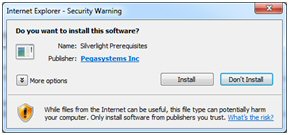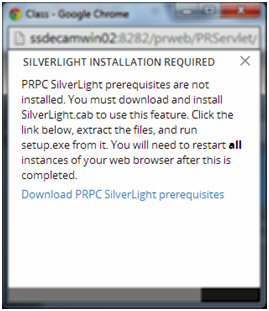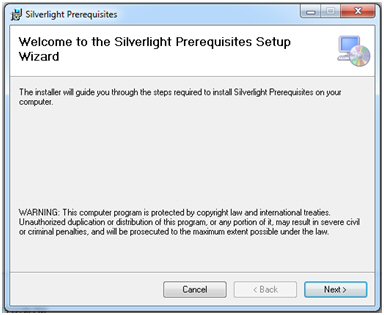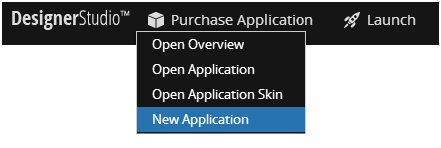Word merge support with Microsoft Silverlight plug-in
Valid from Pega Version 7.1.3
PRPC features that integrate with the Word merge capability are now cross-browser. ActiveX controls (which are only compatible with IE) have been replaced with Microsoft Silverlight. This plug-in must be downloaded separately from Microsoft, as it is not shipped with PRPC.
Some common PRPC features affected by this change include the Application Document Wizard, App Profile, Specifications Landing Page, Specification form, and Case Type Landing Page.
Prior to using these features, Users of PRPC 7.1.3 need to set up their client system(s) as follows:
1. Install Silverlight plug-in
Follow the PRPC prompt to install Silverlight when you attempt to use the Word merge feature:

Or download package directly: www.microsoft.com/silverlight/
2. Install PRPC prerequisites
Microsoft Internet Explorer (IE) browsers automatically detect the need for PRPC prerequisites and will prompt for install:

Non-IE browsers will load a pop-up window when the user attempts to use the Word merge feature. Use the link to manually download PRPC prerequisites:

Extract the .zip file, execute setup.exe and follow the install wizard:

Administrators setting up multiple clients at once may refer to the pzSLpreReqs.cab available in the PRPC 7.1.3 resource kit.
3. Restart browser
Log out of PRPC, close all open sessions and restart your browser.
The PRPC feature integrated with Word merge is now ready for use; Silverlight prompts are no longer displayed.
4. Troubleshooting
Silverlight installation requires access to your file system and a registry setting update to “trust” the associated Verisign certificate. Contact your administrator if you encounter any security or permission errors during this process.
See the PRPC Developer Help for more information on browser setup requirements.
Organization Setup superseded by New Application Wizard
Valid from Pega Version 7.1.3
The Organization Setup Wizard has been retired in PRPC 7.1.3. This feature was previously launched from the Designer Studio > Org & Security > Organization > Organization Setup menu. Users are encouraged to run the New Application Wizard (also known as Application Express) instead:

This tool quickly generates an application along with all of the artifacts previously offered by the Organization Setup Wizard. This includes, but is not limited to, the class hierarchy, application rule, organization/division/unit rules, and all relevant data instances.
See the following PDN article for more details on the New Application Wizard:
Create new applications quickly and easily with Application Express
Enabling security policies now requires current password
Valid from Pega Version 7.1.3
As part of Pega’s initiative to protect against malicious attacks, the change password dialog has been enhanced. When Security Policies have been enabled for your system, new users or those with expired passwords will now be prompted for both their existing password as well as their desired new password.
For more details, review the Designer Studio > System > Settings > Security Policies landing page.
Required Oracle optimization parameter
Valid from Pega Version 7.1.3
To optimize performance, set the Oracle parameter optimizer_index_cost_adj to a value between 20 and 25. If this value is not set, the system can run exceedingly slowly, potentially blocking users from login.
Synchronized database and application server settings
Valid from Pega Version 7.1.3
Configure your database and application server to use the same time zone and character encoding to avoid conflicts.
View status of custom search indexes
Valid from Pega Version 8.1
Custom search indexes are special purpose indexes that are created and managed outside of Pega Platform™. You can view the status of custom search indexes on the Search landing page to see whether they are complete. This information is useful for troubleshooting and can help you determine whether to rebuild the index.
For more information, see Checking search index status.
Job Scheduler and Queue Processor rules replace agents
Valid from Pega Version 8.1
The Job Scheduler rule and the Queue Processor rule replace agents and improve background processing. The Job Scheduler rule is used for recurring or scheduled tasks, such as sending summary emails on weekdays. This rule can be run on all nodes or on specific node types according to your customized pattern. The Queue Processor rule is used for tasks with no recurrence-based pattern. It provides scalability and capability for immediate or delayed message processing, such as submitting status changes to an external system. You can use a standard queue processor or a dedicated queue processor, depending on your processing needs.
Pega Platform™ provides a set of default queue processors and job schedulers. Corresponding agents are no longer available.
For more information about Job Scheduler and Queue Processor rules, see Job Scheduler, Replacing an agent with a Job Scheduler rule, Queue Processor, Replacing an agent with a Queue Processor rule.
Improve application test coverage by running multiple sessions
Valid from Pega Version 8.1
You can improve the test coverage of your application by using a new test coverage method - Application Coverage. Multiple users can perform coverage sessions which are aggregated into a single report. By using report metrics that show the number of rules that are covered and are not covered by tests, developers can identify which areas of the application need more test coverage.
For more information, see the Test Coverage landing page.
Support for OAuth 2.0 authorization code grant type
Valid from Pega Version 8.1
Pega Platform™ now supports the OAuth 2.0 authorization code grant type, which allows Pega Platform to act as an OAuth 2.0 access token provider for native applications on mobile and other devices. By using the authorization code grant type for mobile clients, you no longer need to implement a variety of standards for various authentication providers. The authorization code grant type also supports the Proof Key for Code Exchange standard (PKCE) for securing public clients.
For more information, see Creating and configuring an OAuth 2.0 client registration.
Use client-based access control to support EU GDPR requirements
Valid from Pega Version 8.1
You can use client-based access control (CBAC) to satisfy the data privacy requirements of the European Union General Data Protection Regulation (GDPR) and similar regulations. By using client-based access control, you can identify the personal data of clients and automatically process requests to view, update, or remove the data in a secure manner. You can also enforce restrictions on the use of this data in application functions.
For more information, see Client-based access control.

